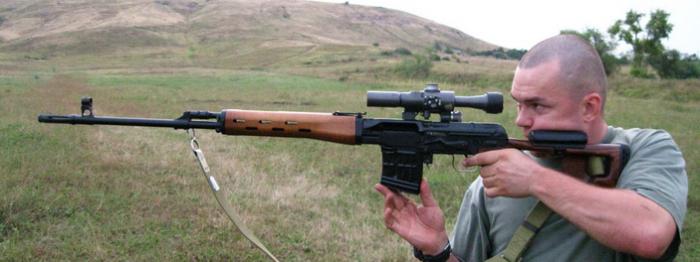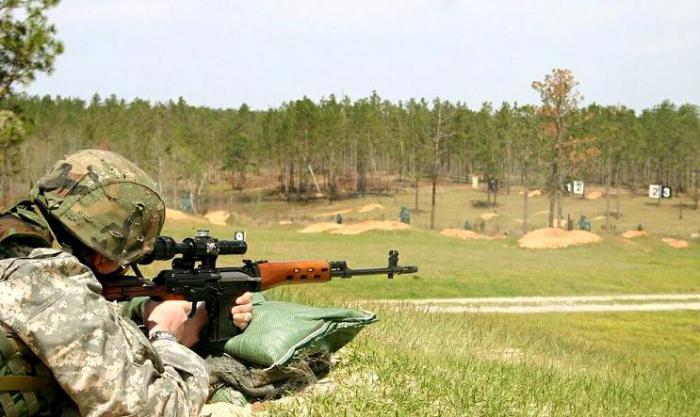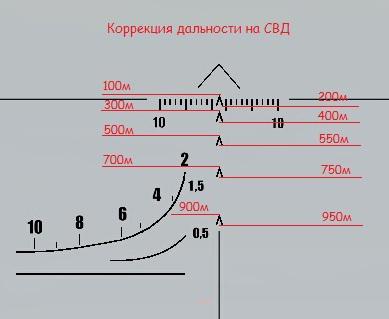The 7.62 caliber SVD sniper rifle was developed in 1958-1963 by Soviet designers under the leadership of E.F. Dragunov. It is a self-loading weapon, its automation is based on the use of the energy of powder gases removed to the gas piston from the barrel bore.
Excerpts from the Soviet Military Encyclopedia
Snipers are specially trained shooters who are fluent in the art of camouflage, observation and marksmanship; know how to hit targets from the first shot. Officially, the first snipers appeared in the English army during the First World War. The main task of such fighters is to destroy important moving, open, disguised and appearing single targets. It can be enemy snipers, observers, officers, liaisons, etc. The shooter is armed with a rifle equipped with a special sight. For shooting, he selects and equips a hidden position. During the Second World War, all participants in the armed conflict widely deployed the training of snipers, special schools were created for this, training camps and courses were held. In the USSR, the mass mastery of this art was called the sniper movement. In addition, this concept became a household name, as a result they began to call them well-aimed shooters of aviation, artillery and tank troops.
Sniper rifles are equipped with optical sights, which improve the accuracy of aiming and provide good observation in any conditions. For firing at night, night vision sights are installed on the weapon or the illumination of the optical grid is turned on. Until the beginning of the 60s of the last century, the Soviet Army did not have specialized sniper rifles, and Mosin carbines of the 1891/30 type were used. However, the methods of warfare were changing, and the experience of past local conflicts set a number of requirements for sniper business. So, a new stage has begun in the development of this type of weapon. Now all the elements were developed and manufactured by special orders, from the cartridge and the optical sight to the rifle.
The history of the creation of the first Soviet sniper rifle
In 1958, the USSR Ministry of Defense issued a tactical and technical task for the development of self-loading 7.62 caliber sniper weapons. The main competitors in this competition were Izhevsk designer E.F.Dragunov and A.S. Kovrov designer, in addition, Simon S.G. and Kalashnikov M.T. design team presented their samples.A version of the experimental SSV-58 rifle presented by Dragunov was able to the first to "meet" the tough demands made by the military, after which the modified model CCV-61 appeared. After comparative testing of prototypes Konstantinov and Dragunov made a decision on the adoption of the project Dragunov. Thus, the SVD, a rifle, the characteristics of which met all the set requirements, entered the troops already in 1963, under the index 6B1.
With the world on a thread ...
The development of ammunition for the new rifle was carried out by employees of the research institute No. 61 V. Sabelnikov, P. F. Sazonov and V. N. Dvoryaninov. This cartridge with a bullet having a steel core was adopted four years after the rifle itself ( in 1967) and received the index 7H1. The engineers of Ovchinnikov A.I. and Glyzov L.A. were responsible for the development of the PSO-1 optical sight. they are almost identical to automation with the removal of powder gases from the barrel through the side hole, locking the channel by turning the shutter and double-acting non-automatic flag fuse. In addition, the trigger mechanism has a similar shape of a combat spring. No doubt, some elements were borrowed from AK, but the SVD rifle is not a copy of the machine, it is an independent system, and the features of this weapon, which we give below, serve as proof of this.
Interesting differences of the Dragunov rifle associated with "sniper" tasks
Let's look at the differences that make this weapon an independent system. The SVD rifle has a bolt frame that is not combined with a gas piston, which (like the pusher) is made as a separate part with its own return spring. They occupy their original position after the frame is discarded. The movement of automation is decomposed into successive movements of individual parts. Accordingly, this leads to an increase in the response time of the mechanism and a decrease in the total mass of the jointly moving parts. This principle increases the smoothness of the automatic operation and smoothes the pulse load. In addition, the gas outlet unit has a gas regulator necessary to adapt the self-loading mechanism to work in difficult operating conditions.
Shutter mechanism
The SVD rifle is equipped with a bolt device that has three symmetrical warheads. This makes the locking process more reliable and also reduces the angle of rotation of the mechanism. The reloading handle is located on the right side and is made as a unit with the bolt frame. The combination of this massive design with a light shutter can provide a very reliable operation.
Trigger mechanism
USM of this sniper rifle is assembled in a separate building, it is able to provide only a single fire. An original feature of the mechanism under consideration is the use of a trigger (in addition to its main function) as a disconnector of the sear and trigger pull. The non-automatic flag fuse in the on state blocks the traction and the trigger, and also closes the cutout at the receiver.
Lodge and butt SVD
The SVD rifle has a characteristic cutout in the butt, which forms a pistol grip with its front face. The frame shape allows you to hold the weapon with your left hand, firing from the stop. On the butt, you can attach an unregulated removable "cheek" and butt pad. The forend is formed by two symmetrical barrel linings, which have slots for better cooling of the rifle. The linings are equipped with a spring-loaded mount, so that the fulcrum of the box is on the axis of the barrel. As a result, the force created by the supporting rifle arm does not affect the results of the shooting. In addition, when lengthening the barrel, caused by its heating during firing, the forearm is shifted slightly forward; since the engagement conditions do not change, there is no displacement of the so-called midpoint. Since the beginning of its existence, the SVD (the photos in this article demonstrate the weapons we are considering) has undergone several stages of modernization. As a result, the wooden butt and forend were replaced by glued plywood boards, and the modern version is available with a plastic butt and overlays made of glass-filled polyamide in black. Thanks to these changes, the weight of the SVD has decreased.

Ammunition
As mentioned earlier, the caliber SVD is 7.62x53. The power of the rifle is carried out from a two-row metal box-shaped detachable clip of a sector shape, the capacity of which is ten rounds. The designers provided for the location of the store so that the center of gravity of the weapon was located above it. As a result, the consumption of cartridges has virtually no effect on the balance of the rifle, and therefore on the displacement of the midpoint of hits. For firing from a sniper Dragunov use, in addition to a special cartridge 7N1, also a rifle cartridge 57-N-223 with a light bullet, 7T2 with a tracer bullet, as well as 7B3 with an armor-piercing incendiary charge, etc.
Optical instruments
The SVD PSO-1 optical sight has a four-fold increase with a field of view of 6%. It is equipped with a retractable protective hood and a rubber eye cup. The reticle has a main square, designed for firing at a range of up to one kilometer, as well as additional ones - at 1.1, 1.2 and 1.3 km - and a scale of lateral corrections. In addition, the PSO-1 provides a rangefinder scale, using which the aiming range of the SVD provides a target height of 1.7 m (full-length human figure) with an accuracy of up to 50 m. The illumination device of the aiming grid is powered by one battery inserted into a special compartment in case. A luminescent plate is introduced into the field of view of the optics, which makes it possible to detect sources of infrared radiation. As an auxiliary, a mechanical device is used - a sector sight, designed for a range of up to 1.2 km, as well as an adjustable front sight. Optics PSO-1 served as the basis for creating a whole family of sights, including PSO-1 M2. The effective range of the SVD with this model is in the range from 0.1 to 1.3 km. In 1989, new 1P21 devices appeared. This SVD optics has a variable magnification factor from 3 to 9, its field of view is 6 ° 11 '- 2 ° 23', respectively. In addition, the device allows you to use the illumination of the reticle with the ability to adjust brightness.

SVD rifle: weapon characteristics
The total length of a weapon without a bayonet is 1225 mm, and the barrel length is 620 mm. Weight with an equipped magazine and an optical sight - 4.52 kg. Cartridge - 7.62x53. The initial speed of the bullet is 830 m / s. Combat rate of fire - 30 rounds per minute (a pretty good result, considering only the single mode of fire with the SVD rifle). The firing range with an optical sight is 1300 meters, and with a mechanical device - 1200 meters. Magazine capacity - 10 rounds.
Principle of operation
Automatic weapons operates on the principle of using the removal of combustible powder gases through a special hole in the bore. Locking is carried out by turning the bolt mechanism counterclockwise. The main difference from the Kalashnikov’s scheme is that the rammer is also used as an additional combat support (the third in a row). This allowed, without changing the transverse dimensions of the shutter and the angle of rotation, to increase the area of combat stops by about one and a half times. As a result, three reference points provide a very stable position of the mechanism, which could not but affect the increase in the accuracy of fire. When firing, part of the powder gases that follow the bullet rushes into the gas chamber through the gas outlet channel in the barrel wall and presses on the front wall of the piston. As a result, the piston together with the pusher and the slide frame are thrown into the rear position.

At this moment, the barrel bore opens, the bolt removes the sleeve from the chamber and throws it out of the receiver. After that, the bolt frame compresses the return spring and cockes the trigger, that is, sets the platoon of automatic descent. Further, under the action of the return mechanism, all structural elements return to their original forward position. At the same time, the bolt sends the next cartridge from the holder to the chamber and locks the barrel, the bolt frame removes the self-timer in the cocking and puts it on the cockpit. Locking the barrel with a bolt is carried out by turning it to the left and staging combat protrusions in the cutouts of the receiver.
In order to produce another shot, you should release and press the trigger again. After its release, the thrust moves to the front position and with its hook jumps over the sear. When you click on the hook, the hook turns the sear, thereby disconnecting it and the cocking cock. The latter, under the action of the mainspring, rotates along its axis and hits the drummer, which moves to the front position and pierces the capsule. The cartridge powder mixture ignites and a shot is fired. When the last shot is fired, the shutter slides back, and the cartridge feeder raises the shutter stop up. He abuts, and the frame stops in the rear position. This serves as a signal to the shooter that the weapon should be loaded again.
Use concept
For hand-to-hand combat, a bayonet-knife of the standard type (6x4) can be attached to the SVD. Although this attribute on a sniper rifle is very rare and hardly needed. Nevertheless, one should not forget that this weapon was created as equipment of small subversive units, and this obliged to provide for its use even in close combat.
In general, the design of the SVD, the characteristics of which turned out to be quite impressive, was a very successful compromise between the general combat and sniper requirements. In addition, it should be noted that this rifle became the first army weapon, the design of which clearly showed the features of sports equipment. For the 60-70s of the last century, SVD had a very high accuracy. Experience has suggested that with this sniper rifle you can hit subtle targets at a distance of up to 800 meters. The range of the SVD for the target of the "chest figure" type (50x50 cm) reaches 600 meters, and for the "head figure" (25x30 cm) - 300 meters.
Battle glory
This sniper rifle gained quite high popularity during military conflicts in Afghanistan and Chechnya. This is due to the high power of the SVD, the characteristics of which made it possible to conduct accurate fire in mountain conditions. It can be noted that not a single type of battle is complete without the active participation of snipers, so this type of weapon has been and will always be in demand.
To date, various modifications of the SVD are in service with the armies of more than a dozen countries. Various options were issued in China, Iraq, Romania. In addition, the fate of the model we are considering manifested the influence of sniper, hunting and sports weapons. Indeed, the SVD rifle, designed using the experience of sports shooting, had a serious impact and served as the basis for the creation of a series of hunting carbines such as the Bear, Tiger, and OTs-18.
SVD sniper rifle: price
Novice hunters are often interested in whether they can purchase military weapons, in particular the SVD rifle, as a hunting one. However, the law of the Russian Federation prohibits the sale of SVD to private ownership. Nevertheless, there is a way out: the Izhevsk plant is finalizing the original combat specimens of the Dragunov rifle, taken off preservation. As a result, anyone can buy this copy, produced in accordance with the requirements of the forensic investigators of the Ministry of Internal Affairs of the Russian Federation under the restrictions established for the circulation of official and civilian weapons. However, we immediately reassure the reader - these changes in no way affect the operation and technical characteristics of this rifle. To its name is added the prefix KO, which means "hunting carbine." The cost of the SVD insurance company is 62 thousand rubles. If the hunter is not frightened off by the high price, he will receive reliable, powerful, time-tested excellent weapons that will serve him faithfully for a single year.
Finally
The Dragunov sniper rifle has established itself as a powerful and reliable weapon, for many years remaining the best combined-arms model. However, changing, complicating and expanding the military tasks performed by the sniper in modern conflicts, required the development of new rifle systems with significantly better firing accuracy, as well as an aim with a greater brevity of increase. In fact, the SVD was not a sniper rifle in the modern sense of the term, its main task was to increase the effective range of fighters of motorized rifle squads (up to 600 meters in total). And also it was called upon to provide the necessary fire support (to suppress firing points). In this regard, the SVD is not required to possess the range and accuracy of modern sniper weapons. Therefore, despite the adoption of new rifle systems of greater power, the military is in no hurry to abandon the classics tested in battles. So, special forces receive sniper rifles chambered for 8.61 mm, and motorized rifle units continue to use SVD.